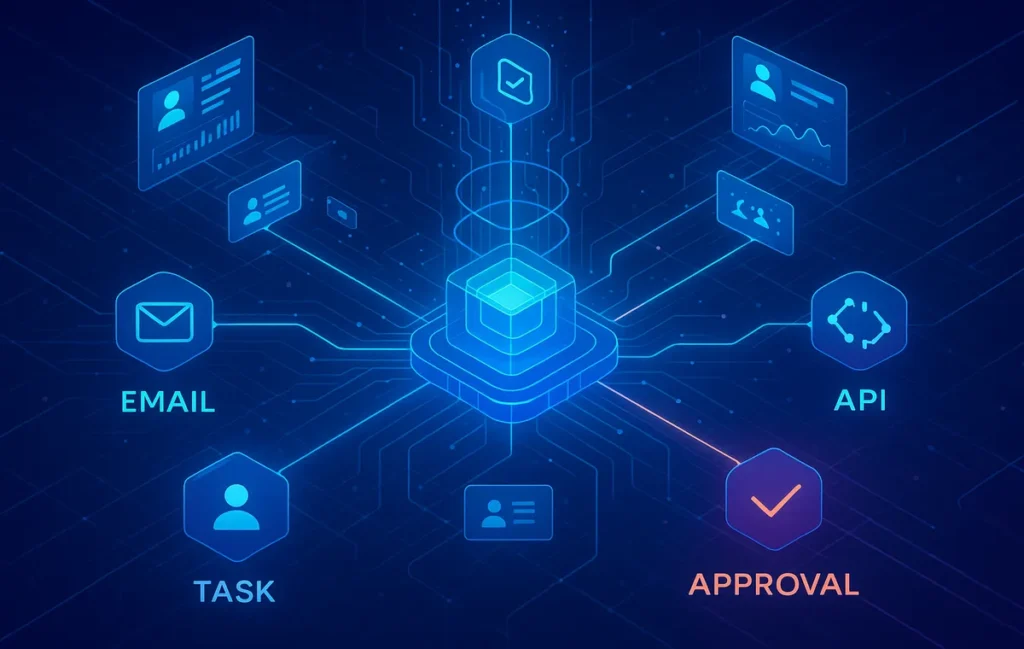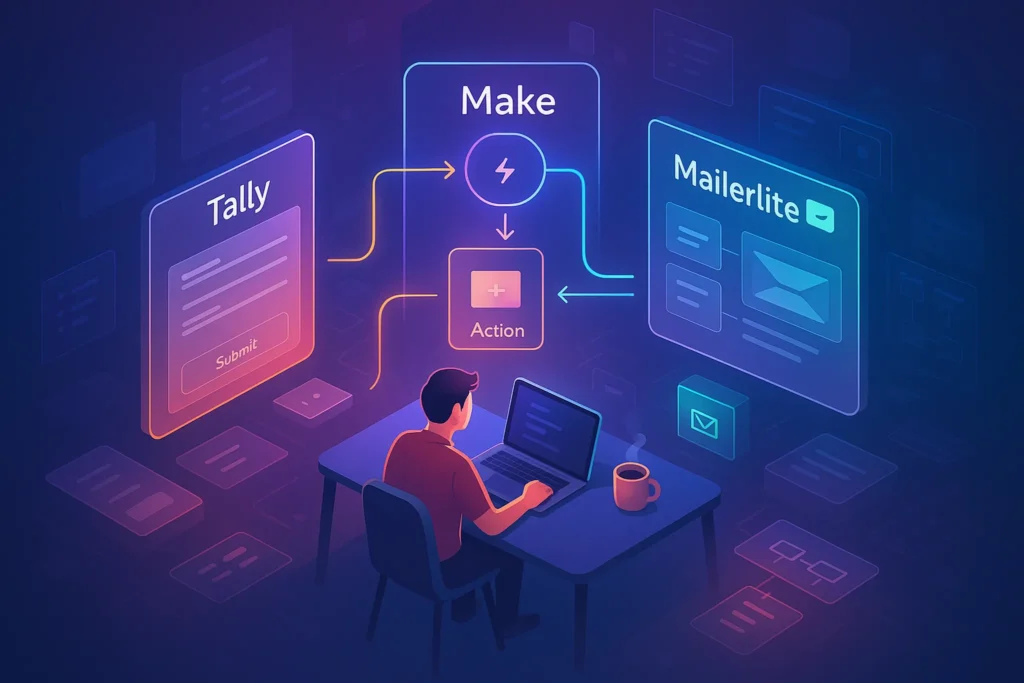🚀 Why Workflow Automation Matters in 2025
The promise of automation has shifted. In the early days, it was about saving a few hours by automating repetitive tasks. In 2025, workflow automation software has matured into the backbone of digital operations. Businesses no longer ask “should we automate?” but “how do we map, trigger, and scale automation so it drives measurable growth?”
At NerdChips, we’ve covered the basics in Workflow Automation 101 and tools tailored for individuals in Best Workflow Automation Tools for Solopreneurs. But this article is about the next level: designing visual workflows that reveal inefficiencies, leveraging advanced triggers that respond to real-world events, and scaling systems across large teams without losing control.
💡 Nerd Tip: If you treat automation as a patchwork of shortcuts, you’ll only save minutes. Treat it as a process architecture, and you’ll gain months of scale.
🗺️ Map: Designing Visual Workflows that Drive Clarity
The first step toward automation in 2025 isn’t building—it’s mapping. Visual workflow design tools have transformed from clunky drag-and-drop interfaces into interactive process maps that feel closer to living dashboards.
Modern platforms like n8n, Make, and Zapier AI now allow teams to sketch workflows in real-time, showing not just the steps but also the dependencies and potential bottlenecks. A marketing agency, for example, can map its lead pipeline from form submission to CRM update to Slack notification—all visible as one living process. This clarity eliminates hidden inefficiencies that often eat 10–15% of a team’s time.
Mapping also bridges strategy with execution. Executives can finally see the logic behind automations, not just the outcome. This transparency reduces resistance to adoption in larger companies, where “shadow automation” often caused IT headaches in the past.
And mapping isn’t only about clarity. It’s a form of process governance. When workflows are visible, it’s easier to ensure compliance, standardize best practices, and onboard new employees quickly. For startups planning to scale, a strong map is the blueprint of operational resilience.
⚡ Trigger: Beyond Clicks to AI-Powered Actions
Triggers have evolved. The earliest automations fired when someone clicked a button or filled a form. In 2025, triggers are deeply intelligent, pulling signals from the web, internal systems, and even AI models.
Webhooks remain powerful for real-time integrations, but AI-driven triggers have taken center stage. Imagine an AI that monitors customer support emails and only triggers workflows when sentiment analysis detects frustration. Instead of logging every ticket, the system escalates only the ones at risk of churn.
Another example: an e-commerce store integrates real-time weather data. When a storm hits a target region, the automation triggers a custom email campaign for rain gear—an approach that lifted one retailer’s campaign ROI by 15% quarter-over-quarter.
This level of sophistication is why comparisons like Zapier vs. Power Automate vs. IFTTT matter less about “who connects more apps” and more about “who interprets signals best.” In 2025, the race is about context-driven automation.
💡 Nerd Tip: Don’t just automate inputs. Automate intelligence by using AI triggers that understand context and prioritize what matters.
📈 Scale: From Solopreneur Hacks to Enterprise Systems
Scaling automation is where businesses succeed—or collapse. What works for a solopreneur often fails in a 500-person organization. Scaling requires governance, monitoring, and fail-safes.
Enterprise-ready platforms in 2025 emphasize orchestration layers. These layers don’t just run automations; they monitor them, track failures, and ensure that one broken trigger doesn’t take down an entire department’s workflow. A multinational company that adopted Make’s enterprise edition reported saving over 2,000 hours per quarter, but more importantly, they prevented cascading failures that once cost them client trust.
Scaling also means thinking about roles. Automation isn’t the job of IT alone anymore. “Citizen automators”—employees in marketing, sales, and operations—are now building flows. To prevent chaos, platforms enforce role-based access control and audit logs. This way, a marketing intern can automate social posting without accidentally touching payroll systems.
This shift mirrors the trend we saw in Top 10 Automation Tools for Marketers, where specialized teams use automation to move faster without waiting on IT. In 2025, scale doesn’t mean more tools. It means centralized control with decentralized creativity.
📊 Benchmarks & Real-World Numbers
Numbers prove whether automation is hype or transformation. Recent surveys show that teams implementing advanced workflow automation in 2025 report:
-
3x faster process execution times across sales and marketing funnels.
-
25–30% reduction in manual data entry errors, thanks to AI-powered validation triggers.
-
ROI lift of 12–18% in campaign performance when workflows integrated real-time data (like weather or sentiment).
One failure case is just as instructive. A SaaS startup tried chaining 40+ automations without monitoring. A single webhook error cascaded, sending 300 duplicate invoices. This highlights the need for monitoring and orchestration layers at scale.
💡 Nerd Tip: Benchmark your automations quarterly. Success isn’t just more flows—it’s measurable outcomes like fewer errors, faster cycles, and clear ROI.
⚡ Ready to Build Smarter Workflows?
Explore workflow automation tools like HARPA AI, Zapier AI, and n8n plugins to map processes, trigger AI actions, and scale without friction.
📂 Case Studies: Startup vs. Enterprise in Action
Case studies show how automation plays out in the real world, beyond marketing promises.
For startups, the story is speed. A SaaS team of five implemented Zapier AI combined with browser automation. Before automation, lead qualification and follow-up emails took two hours daily. By mapping a simple workflow—form submission → webhook trigger → AI-generated response → CRM entry—the team reclaimed over 40 hours a month. More importantly, the system scaled with growth: when leads tripled after a product launch, the workload didn’t. A founder shared on X: “Automation is why we didn’t hire earlier. It gave us oxygen to grow.”
In enterprises, resilience is the priority. A financial services company deployed Make Enterprise to orchestrate 70+ workflows across departments. They paired automations with role-based controls and compliance monitoring. In one quarter, they reduced manual reporting errors by 28%, saving millions in regulatory fines. Unlike the startup, their ROI wasn’t just speed—it was risk reduction. Without orchestration, a single failed webhook could have crippled multiple teams.
These two examples underline the spectrum: startups use automation to multiply capacity, while enterprises rely on it to enforce consistency at scale.
⏱️ Human Factor & Change Management
Automation is as much about people as it is about tools. Many failed projects didn’t collapse because the software broke, but because teams resisted change. Employees feared “robots taking jobs,” or worse, found workflows confusing and reverted to manual processes.
To succeed in 2025, companies must invest in automation literacy. Training “citizen automators” has become standard practice, empowering employees in marketing or HR to build their own safe automations without IT gatekeeping. This democratization unlocks innovation—if guided well.
Change management also means building trust. Communicating that automation removes drudgery, not creativity, is crucial. A mid-size agency we observed rolled out an internal slogan: “AI handles the boring, we handle the bold.” Adoption rose by 60% compared to a previous rollout attempt.
💡 Nerd Tip: Don’t drop automation on teams like a surprise. Co-create it with them. If people help build the workflows, they’ll fight to keep them alive.
📡 Future Trends: Looking Beyond 2025
While today’s workflows are impressive, the future will push boundaries even further.
One trend is AI agents managing event-driven systems. Instead of static flows, AI will monitor metrics and reconfigure processes dynamically. For example, if a CRM conversion rate dips below 10%, the system might automatically trigger an A/B test campaign, reroute leads, and update dashboards—without human prompts.
Another frontier is cross-platform orchestration. Current tools mainly stitch apps together, but emerging platforms act as intelligent hubs that balance loads, predict bottlenecks, and proactively recommend optimizations. Think of it as “autopilot for operations.”
Finally, embedded automation will replace standalone dashboards. Future CRMs, marketing suites, and even note-taking apps will include native automation layers. The boundary between “tool” and “workflow builder” will blur, as explored in Top 10 Automation Tools for Marketers.
For businesses planning long-term, adopting flexible platforms now will ease migration into these agent-driven futures.
⚠️ Common Pitfalls to Avoid
Not every automation journey is smooth. In fact, many failures stem from predictable mistakes.
Over-automation is the most common. A team builds dozens of workflows without governance, leading to a spaghetti mess where one failure cascades through the system. This is what happened to a SaaS startup that accidentally sent 300 duplicate invoices in a single day.
Vendor lock-in is another trap. Choosing a flashy tool without export options can leave teams stranded if pricing changes or compliance demands shift. Always evaluate exit strategies.
Complexity creep also kills momentum. Teams sometimes automate trivial tasks that add little ROI, creating noise rather than efficiency. The key is prioritization—automate what scales value, not just what feels fun.
💡 Nerd Tip: Audit your workflows quarterly. If you can’t explain why an automation exists or what it saves, it’s a liability, not an asset.
📌 Decision Framework: Picking the Right Path
Choosing workflow automation software in 2025 isn’t a one-size-fits-all decision. Use this framework to match solutions to your context:
-
If you’re a solopreneur or small team: Focus on low-cost, flexible tools with strong visual mapping. Zapier AI or n8n are often enough to scale until headcount grows. (See Best Workflow Automation Tools for Solopreneurs for details.)
-
If you’re a growing startup: Prioritize advanced triggers and ecosystem integrations. Real-time webhooks and AI-powered actions help maximize limited manpower.
-
If you’re an enterprise: Orchestration, compliance, and monitoring matter most. Platforms like Power Automate or Make Enterprise shine here, ensuring resilience across departments.
This decision tree reframes automation as a strategic investment rather than a trendy experiment. The wrong tool wastes time; the right one redefines operations.
🌍 Integration Ecosystem and Browser Automations
Integration is no longer a feature—it’s the battlefield. Businesses choose platforms not just on how many apps they connect, but on how seamlessly they fit into a broader tech stack.
Zapier AI’s predictive workflows recommend next steps based on previous patterns, while Power Automate’s native connection to Microsoft 365 makes it indispensable in enterprise ecosystems. Meanwhile, browser-based automation is exploding, with tools that mimic human navigation to handle legacy systems. Teams frustrated by apps without APIs are finding relief through these browser automations, tying directly to use cases explored in Save Time with Browser Automation.
The result is an ecosystem where automation feels less like a separate layer and more like a native part of daily software usage.
📬 Want More Smart AI Tips Like This?
Subscribe to our free newsletter for weekly strategies on workflow automation, AI tools, and scaling systems—crafted by NerdChips.
🔐 100% privacy. Only battle-tested insights. No hype.
🧠 Nerd Verdict
Workflow automation in 2025 isn’t just about connecting apps. It’s about building operational maps, designing intelligent triggers, and scaling responsibly. The winners aren’t the businesses that automate everything, but those that automate the right things—with governance, clarity, and creativity. At NerdChips, we believe automation is no longer a productivity hack; it’s a competitive advantage.
❓ Nerds Ask, We Answer
💬 Would You Bite?
Do you see automation as a way to save hours, or are you ready to map and scale it into the backbone of your business?
Crafted by NerdChips for creators and teams who want their best ideas to travel the world.



